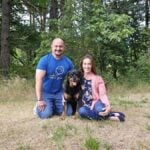


Home » Judging the Cane Corso
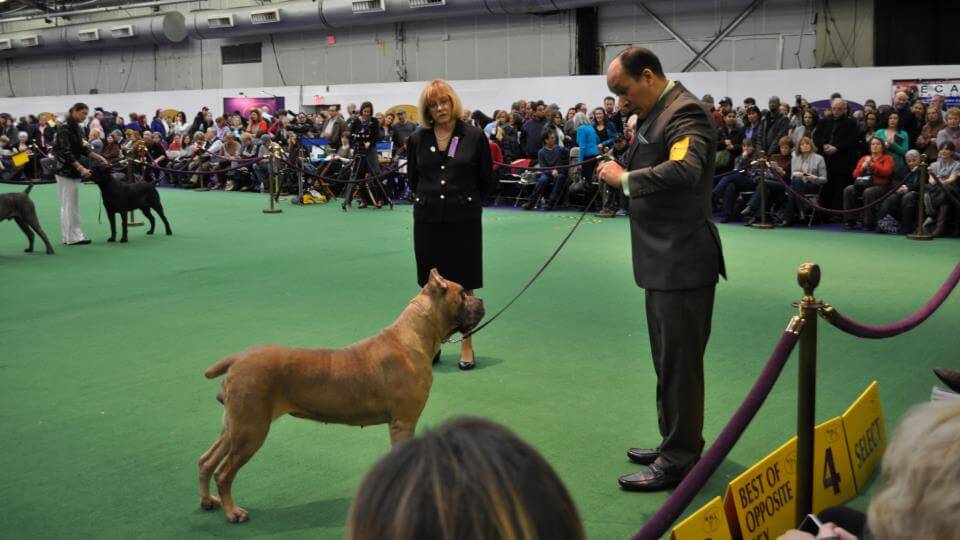
This article was originally published in Showsight Magazine, January 2014 issue.
Since the Cane Corso first appeared in the AKC show rings in July of 2010 we have seen a dramatic increase in the popularity and subsequent recognition of this magnificent breed. The breed has gone from relative obscurity to Rock Star-like status seemingly overnight. Obviously, there are some upsides to this sudden rise in popularity but for those of us that know and love this breed it’s also clearly a valid reason for concern.
An example I typically cite when new people call me with interest about the breed is this:
Many years ago when we first started out no matter where we would go the mere presence of these dogs with their impressive physiques and imposing looks would literally stop traffic in an effort to get a closer look. Today, the same can be said with the main difference being that back then no one knew what breed of dog they were. Now the first thing we hear is “That’s a Kane Corso” (wrong pronunciation) the 2nd thing we hear is that they know someone that has one and the 3rd thing we hear is “Do you want to breed that dog?”
The reason I’m mentioning any of this in an article about judging the Cane Corso is with this huge interest increase it is more important than ever for those who love this breed to preserve the best examples of breed type, characteristics, health and temperament that we possibly can. So for those particular judges in the AKC whose job it is to now accurately judge the Cane Corso—as if their job is not difficult enough—clearly looks to get more challenging in the future as a result of this popularity explosion.
Again; as the breed quickly made its presence felt in the summer of 2010, it was clear that the judges were at best apprehensive when given the assignment to judge this breed.
This was expected and after all understandable, given the varying accounts and differing descriptions of who and what these dogs were bred for and are capable of. In that first year all of us that had seen this breed evolved to this point worked diligently to present the best examples of the breed in conformation but even more importantly in temperament. This was in a concerted effort to put our judges at ease and allow them to begin to judge our dogs without feeling apprehensive based on knowledge (or possibly the lack thereof), or fearful based on the esthetic qualities of the breed – there’s no other way to explain it—the Cane Corso has presence.
To that end and for all things considered, I believe the judges have done a pretty good job when given the challenging assignment of judging the Cane Corso over their first three years in the AKC.
With that being said, I think it is fair to say the future of our breed and its ultimate destiny in the years to come will rely heavily on what we see in and around the AKC show rings throughout the country.
Obviously, it would be impossible in this short article to address every aspect of the Cane Corso standard so what I will attempt to do here is touch upon some of the areas that I think are of critical importance when judging the Cane Corso.

I like to refer to this description as basically “balance” and “soundness”. We must always remember the Cane Corso is a working dog bred for a purpose—first and foremost they should exhibit the clear ability to move soundly and effortlessly as any working dog should.
For me a sound dog is of critical importance when judging the Cane Corso.
The movement should be powerful with an almost effortless appearance. The reach and drive should be strong and impressive while the feet converge towards a center line of gravity in a seemingly single track and must never cross over in the front or the back.
Side gait in the “Around” moment should show a level topline with minimal bounce and roll with the head held slightly above level and the tail flowing at a natural angle and not tucked up against its rear.
In my opinion, more important than the side gait is the “Down and Back”. It is critical to sound movement. In the “Down” movement the feet should not splay outward and both the feet and hock should closely resemble the up and down motion of piston rods in a motor as the dog moves away. The hocks should move solidly and deliberately with the feet with no giggle, wobble, or movement from side to side. In the “Back” movement the front feet should also not splay outward or be thrown from the shoulder, elbow or wrist. The front legs and feet should appear to work in unison with the rear with minimal distraction of any kind.

With regard to head type, I would like to make it clear that I am against referring to or classifying the Cane Corso as a quote “Head Breed”. I think this leads to too much attention being given to the head; however, I believe proper head type is another critical area when judging the Cane Corso.
When I look at correct head type I also take several things into consideration that are obviously part of the head.
In this area I will touch upon a few of the most important, namely:
The head should also be large with the total length being approximately ⅓ the height of the dog at the withers. The planes of the skull and muzzle should be slightly convergent and never parallel. The skin should be firm and smooth and void of excessive wrinkling. The skull viewed from the front is wide and should not have a round appearance in the area between the ears. We seem to be seeing more and more of these round skulls in the ring and it is simply not correct. The stop should NOT be a right angle, but should be pronounced and flow into the convergence of the skull.
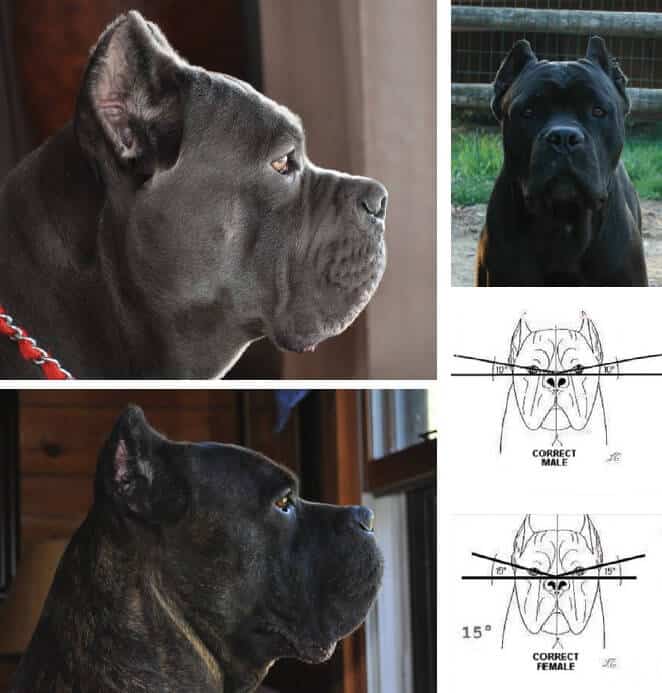
The eyes should be of medium size with a clear almond shape, never bulging or big and round. The rims should be tight-fitting with minimal haw visible. Placement of the eyes is also a very important part of the head piece. The eyes should set slightly above the bridge of the muzzle thus allowing for a clean line of sight without turning its head from side to side. When viewing from the front, correct eye placement should be set at 15 degrees for females and 10 degrees for males as shown in the diagram above.
The nose is another area I concentrate on. The nose should be large with open nostrils. We are seeing too much of what I call “Boxer nose” (a nose more commonly seen on a boxer) with closed nostrils showing up in the rings these days as opposed to the correct larger Molossoid nose with open nostrils. The pigment should be that of the overall pigment of the dog. Dogs that have grey pigment should have a grey nose dogs with black pigment should have a black nose and so on. The nose should be seen as an extension of the muzzle’s topline and should not protrude beyond nor should it recede the front plane of the muzzle.
One of the most important aspects of the head should be its square muzzle. The muzzle should be wide and deep, the width should be almost equal to its length which should be NOT less than 1/3 the total length of the head. Correct muzzle depth should be more than 50% of the length of the muzzle. As viewed from the front the muzzle should also be as wide and as deep and should appear as a trapezoid. The downward view of the muzzle should closely resemble a square. The muzzle should never be narrow or pointy. LIPS: Lips should be firm, thick and hang moderately without excessive dewlap. When viewed from the front they should form an upside-down U as opposed to the upside-down V. Again, the pigment should be that of the rest of the dog.
Slightly undershot (not more than ¼ inch) is preferred, however, a scissor bite is acceptable if the parameters of the under jaw allow for proper expression and muzzle stop. Dentition should be complete with no more than 2 missing teeth.
Every breeder has his or her “gotta have” or “absolutely hate” areas when it comes to our dogs. For me, one of those areas is angulation or more importantly the complete lack thereof.
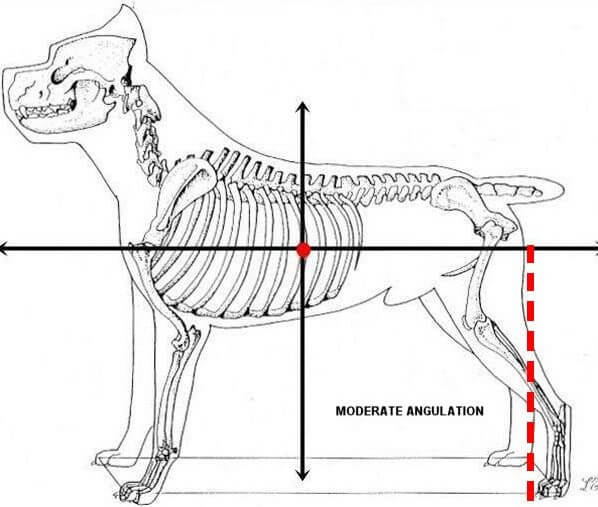
To my earlier point—these are working dogs bred to do a job. The Cane Corso needs to have some kind of angulation not only to avoid injuries such as ACLs and hock issues but it is also needed to perform even the simplest of tasks be it working, hiking, moving in the ring, or out on the trial field. For me personally, having a dog that is straight in the rear gives off the impression of half a dog and it almost always has a negative effect on the topline.
Examples of Cane Corsos that not only have no angulation and are straight in the stifle can be seen in any show ring across the country on any given weekend.
The standard calls for “moderate” angulation. My preference is slightly more moderate than anything less than moderate.
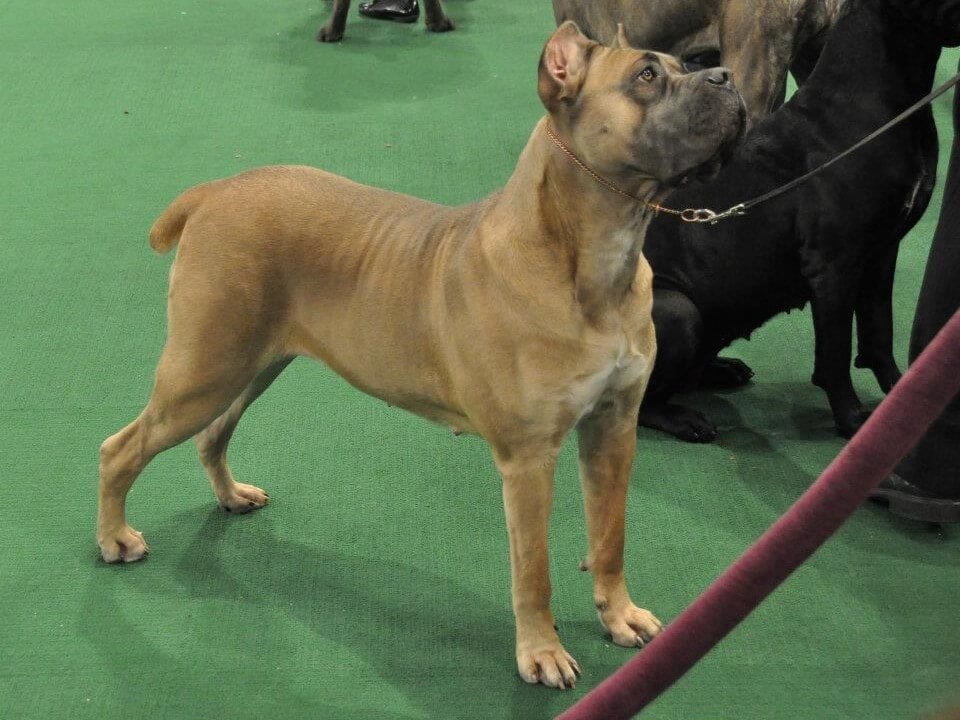
I believe the overall structure of the Cane Corso has to include a solid, powerful rear. Speaking as an experienced breeder who has an ethical conscience, we must strive to keep the balance correct by always being mindful of proper angulation and strong rears. I can see this as being an area that if not closely watched by judges in the ring we could even begin seeing less of it moving forward.
Many breeders in Europe feel that in America, we like too much angulation and most of us here feel that the dogs in Europe lack in this area as well as the rear area overall.

Again, I think it is critical not only in the development of the breed but also in judging these dogs for many years in the future. Something I am always looking to maintain and continue to build upon is a solid rear with balanced and proper angulation. Above are examples of angulation both good and bad and a diagram of the proper way to measure correct, moderate angulation.
